Samsung Galaxy S5 vs Note 3
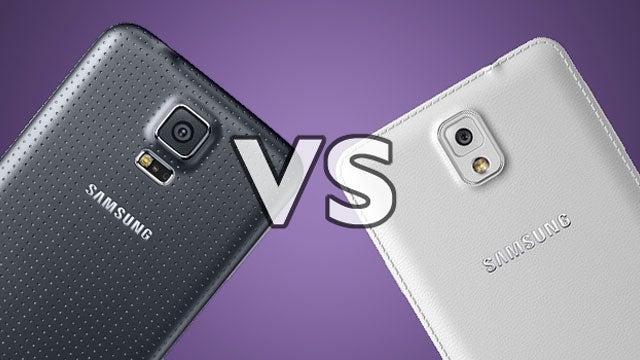
Which is the ideal Samsung phone?
Samsung has become the most important maker of Android phones. It sells more high-end Androids than anyone else, and in the Galaxy S5 and Note 3 it pushes technology in a way that most other manufacturers don’t.
But which of these Samsung flagships should you buy? Both are fantastic phones, but we’re going to compare the two to see which is right for you.
Samsung Galaxy S5 vs Note 3 – Price and Deals
The Note 3 is generally a little bit cheaper than the Galaxy S5. Prices naturally vary between retailers, but where the Note 3 costs around £450 SIM-free, you’ll often pay upwards of £500 for a Galaxy S5.
Some of the best ‘pay as you go’ prices for the phones come from price conscious network GiffGaff, which offers the Note 3 for £442 and the Galaxy S5 for £505. Wherever you go, there’s usually around a £50-60 price disparity between the two phones.
What does this mean when you buy the phones on a contract? Using the figures of Carphones Warehouse, which aggregates deals from the main mobile networks, the cheapest you can get the Galaxy S5 for is about £33 a month. That’s not bad, especially given there is no up-front cost. At launch you’d have been hard-pressed to get the Galaxy S5 that cheap.
The Note 3’s deals start at £28 a month, without any up-front cost. Both these deals are with O2, and you get 500 minutes, unlimited texts and 500MB mobile data. It’s a pretty low-end tariff, but shows you don’t have to spend £40-plus a month to get a high-end phone.
Over the course of those two-year contracts, you’ll spend £120 less on a Note 3. Contracts can be deceptive, and even slight savings will really add up over the course of the contract. Don’t like long 2-year contracts? You’ll almost always have to pay more if you want a shorter-term deal.
Samsung Galaxy S5 vs Note 3 – Design and Dimensions
Galaxy S5 – dimpled plastic back, 8.1mm thick, 73mm wide, 145g
Note 3 – faux-leather plastic back, 8.3mm thick, 79mm wide, 168g
The Galaxy Note 3 was among the first phones to use Samsung’s new style phone design. The company’s mobiles used to have glossy plastic rears but now they tend to favour textured, matt plastic.
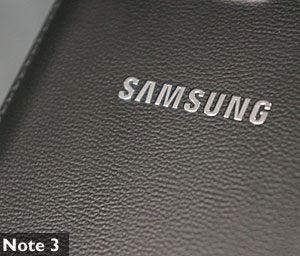 Both phones have a different version of this new style. The Note 3 has a leather effect rear, complete with (slightly cringe-worthy) fake stitching along the sides. The Galaxy S5 has a style all of its own, with a dimpled back that’s lightly textured.
Both phones have a different version of this new style. The Note 3 has a leather effect rear, complete with (slightly cringe-worthy) fake stitching along the sides. The Galaxy S5 has a style all of its own, with a dimpled back that’s lightly textured.
From a distance we think the Note 3 looks a bit better, as the Galaxy S5’s ‘perforated’ dots aren’t exactly a style victory. However, up close the Note 3’s ‘faux’ vibe really lets it down. The S5 looks a little odd, but it’s not obviously trying to pretend to be another material.
Both phones feel reasonably good in-hand but the Galaxy S5 is a slightly more manageable size. Thanks to its smaller screen, the S5 is a good 6mm narrower than the Note 3. You really need two hands to use the Note 3 effectively.
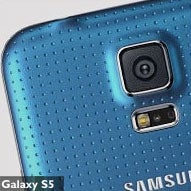 The Galaxy S5 also has one other clear hardware advantage – water resistance. It’s certified to IP67, meaning it can be submerged in water and is impervious to dust. Like other water resistant phones, though, it does this using a rubber-sealed flap that covers the microUSB port, which is a little fiddly.
The Galaxy S5 also has one other clear hardware advantage – water resistance. It’s certified to IP67, meaning it can be submerged in water and is impervious to dust. Like other water resistant phones, though, it does this using a rubber-sealed flap that covers the microUSB port, which is a little fiddly.
You can remove the back cover on both phones but, again, the S5’s has a rubber-sealed surround. We wouldn’t recommend thinking of the Galaxy S5 as a totally waterproof phone – the waterproofing works best as a form of insurance should you get stuck in torrential rain, or drop the phone in the bath. You’re not meant to take it in salt water or chlorinated water, for example.
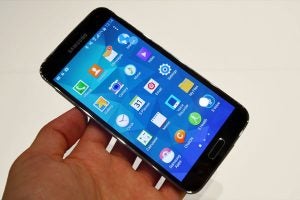
Samsung Galaxy S5 vs Note 3 – Stylus vs no stylus
Galaxy S5 – No stylus, fingerprint reader
Note 3 – S-Pen, no fingerprint reader
The Note 3 misses out on a couple of hardware extras introduced in the Galaxy S5, but it has one massive hardware advantage – the S Pen stylus.
This is a clever pen that interfaces with a digitiser layer in the screen – something missing from the S5. It’s much more than a ‘dumb’ capacitive stylus that you can buy for any modern smartphone.
It is pressure sensitive, which gives a reasonably realistic drawing experience when matched with a drawing app like Sketchbook Pro, which comes preinstalled on the Note 3. Stylus implementation is used throughout the phone too.
You can write freehand instead of using the virtual keyboard, thanks to the integrated handwriting recognition software, and there’s a dedicated nav bar designed just for the S Pen stylus. Samsung is often accused of bunging in features for the sake of it, but the Note series’s S Pen stylus is a real winner. If you’re into that kinda of thing.
SEE ALSO: Galaxy S5 tips, tricks and secret features
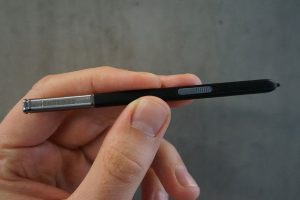
Many of you may not end up using the S Pen that much. But think about whether you would use it first because there’s no way to ‘upgrade’ a Galaxy S5 to get S Pen functionality. The Note 3’s execution of the hardware is pretty good too – the pen is comfortable to use and it can be stored inside the phone, making it less likely to get lost.
The most obvious hardware extra you get with a Galaxy S5 is the new fingerprint reader. It sits under the main select button, and you swipe your finger over it to unlock the phone and authorise payments (if you enable this). Developers will also be given access to this feature to let them make other uses for it. It isn’t as reliable, and thus useful, as that on the iPhone 5S though.
Samsung Galaxy S5 vs Note 3 – Screen
Galaxy S5 – 5.1-inch Super AMOLED 1080p display, Gorilla Glass 3
Note 3 – 5.7-inch Super AMOLED 1080p display, Gorilla Glass 3
The Note 3 has a significantly larger screen than the Galaxy S5. It makes having a digitiser pen worthwhile.
A larger display area is also handy for when you want to watch videos on your phone. However, the quality of the display is a bit better in the Galaxy S5. Samsung has worked on the minutiae of the display (colour calibration, contrast optimisation and so on) to significantly increase how good the screen is, technically – we’re a long way from the hugely oversaturated screen of the Galaxy S3 nowadays.
The Galaxy S5 is also a little sharper than the Note 3, because they have the same screen resolution stretched across different areas. In an RGB subpixel layout, this difference wouldn’t be particularly noticeable. But as these phones use a PenTile subpixel arrangement that decreases how sharp they appear, you can see the difference up close.
That said, we really are being picky here and it won’t be an issue for most people – both screens are extremely pixel-rich. We’re yet to see a phone with a resolution higher than 1080p (as of April 2014) so it’s certainly not like the Note 3 is trailing any other very large-screened phone.
Both phones use Gorilla Glass 3 as their screen covering. This is the latest version of Corning’s toughened glass, and it is super tough. Try hard and we’re sure you’ll be able to smash it, but you can keep these phones unprotected in a pocket for their lifetime without having to worry too much about scratches.
SEE ALSO: Android 4.4 tips and tricks
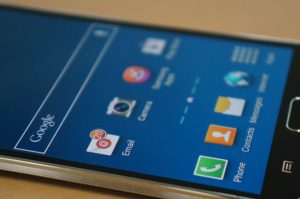
Samsung Galaxy S5 vs Note 3 – Storage
Galaxy S5 – 16GB, 32GB, expandable via microSD
Note 3 – 16GB, 32GB, expandable via microSD
The Note 3 and Galaxy S5 both take the usual Samsung approach to storage. You get a decent amount built-in, either 16GB or 32GB, and there’s a microSD memory card slot to let you add to the storage cheaply.
In each phone, the memory card slot lives under the battery cover, rather than taking up a tray on the side of the phone – as seen in the HTC One M8.
If you would really like to see a higher storage 64GB version of these phones, it’s highly unlikely to come to the UK. Samsung made a 64GB version of the Galaxy S4 but demand for it in the UK was so low that its launch was canned. The real issue is that a microSD card costs about £15 but you can bet you’d pay more than £15 extra for the 64GB version of the phone.
SEE ALSO: Samsung Galaxy S5 vs Galaxy S4
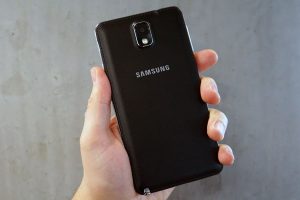
Samsung Galaxy S5 vs Note 3 – Power
Galaxy S5 – Snapdragon 801 CPU 2.5GHz, 2GB RAM
Note 3 – Snapdragon 800 CPU 2.3GHz, 3GB RAM
The Galaxy S5 features a newer-generation chipset than the Note 3, but there aren’t world-changing differences between the Snapdragon 800 and Snapdragon 801 chips used here. The 801’s CPU is just marginally faster, clocked at 2.5GHz rather than 2.3GHz (as in the Note 3). GPU speed is significantly faster, but the same core technology is working under the hood. It’s just working a bit harder in the Galaxy S5.
Read more about the Galaxy S5 processor in our Snapdragon 805 vs 801 vs 800 comparison
The Note 3 comes out top for RAM, too. It has 3GB of RAM while the Galaxy S5 is stuck with 2GB.
When we asked Samsung about why they chose to use 3GB of RAM in the Note 3, they said it was to improve general performance and not anything specific to the phone’s stylus. We found performance in the Note 3 to be sound, but clearly Samsung has decided to back-track a bit on its RAM needs.
This may have also been down to a need to compete with rivals on price, though. Benchmarks are likely to show that the Galaxy S5 is a tiny bit faster than the Note 3, but it is not worth basing your buying decision on.
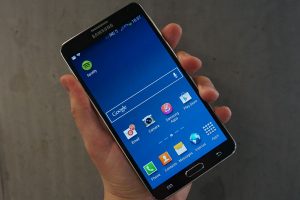
Samsung Galaxy S5 vs Note 3 – Software
Galaxy S5 – TouchWiz 2014, Android 4.4
Note 3 – TouchWiz 2013, Android 4.3 (Android 4.4 on some models)
These are both Android phones, but the actual experience of using them is quite dependent on the custom Samsung interface, known as TouchWiz. Samsung redesigned the software for 2014, with a more streamlined look than before.
However, they’re fundamentally pretty similar. Many of the redesigned elements are one layer down, such as the new-look settings switches.
TouchWiz offers lots of extra features, such as the S Health fitness tracker app. However, not many of them are truly integral to mobile phone use and the interface does feel a little bloated in places. That doesn’t seem to have really changed in the Galaxy S5.
SEE ALSO: Samsung Galaxy S5 vs iPhone 5S

Samsung Galaxy S5 vs Note 3 – Camera
Galaxy S5 – 16-megapixel ISOCELL camera, 1/2.6-inch sensor, LED flash
Note 3 – 13-megapixel camera, 1/3.06-inch sensor, LED flash
The camera is one of the most clearly upgraded parts of the Galaxy S5. Resolution of the main sensor has increased, as has the size of the sensor. This means we’ll get more detailed pictures with the Galaxy S5, without trading away the sort of low-light performance we got from last year’s models.
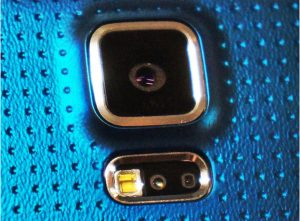 Of course, the Note 3 was never famed for its low-light photography potential. It was something we criticised in our review, in fact.
Of course, the Note 3 was never famed for its low-light photography potential. It was something we criticised in our review, in fact.
However, the Galaxy S5 also has a new kind of sensor, called ISOCELL, which claims to offer better colour reproduction and less image noise – something that will benefit low-light shots.
Another key advantage of the Galaxy S5 is it has phase detection autofocus. This potentially allows for focussing times of 0.3s, which is much faster than the normal contrast detection systems used on every other phone camera.
In daylight, photo quality is fairly similar. You get a bit more detail with a Galaxy S5, but unless you zoom in the perception of detail isn’t hugely different.
Where the Galaxy S5 separates itself from the older Note 3 is with its low-light performance. It is a lot better in the new phone, making it an all-round more versatile camera. Here are a couple of samples to demonstrate – note that the difference in size is down to the actual size of the sensors (although the Note 3 shoots widescreen like the S5 by default):


Which is right for you?
The Galaxy S5 is a more advanced phone than the Note 3 in several respects. Its screen is better-calibrated, the processor is a bit more powerful and the camera tech is significantly more advanced. However, these can all be forgotten if you’ll make proper use of the S Pen stylus and the Note 3’s extra screen inches.


